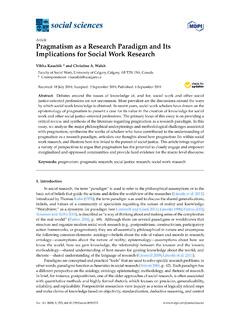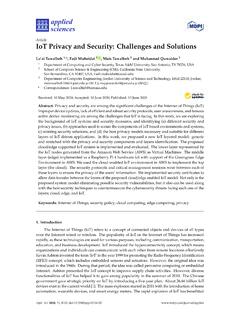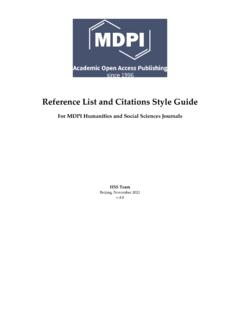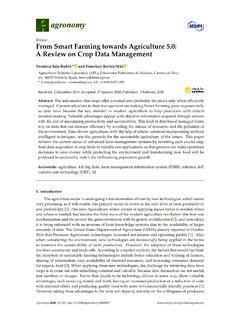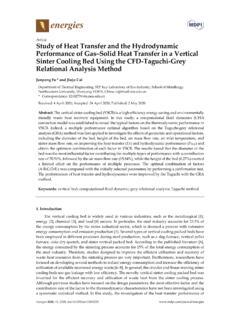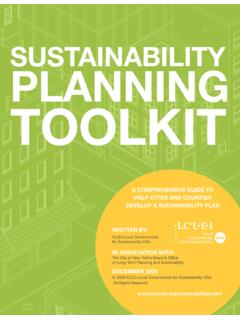Transcription of Review of Online Food Delivery Platforms and their Impacts ...
1 SustainabilityReviewReview of Online food Delivery Platforms and theirImpacts on SustainabilityCharlene Li1,2, Miranda Mirosa1,2and Phil Bremer1,2,*1 Department of food Science, University of Otago; PO Box 56, Dunedin 9054, New ( ); ( )2 New Zealand food Safety Science Research Centre*Correspondence: Tel.:+64-3-479-5469 Received: 10 June 2020; Accepted: 6 July 2020; Published: 8 July 2020 Abstract:During the global 2020 COVID-19 outbreak, the advantages of Online food Delivery (FD)were obvious, as it facilitated consumer access to prepared meals and enabled food providers to keepoperating.
2 However, Online FD is not without its critics, with reports of consumer and restaurantboycotts. It is, therefore, time to take stock and consider the broader Impacts of Online FD, and whatthey mean for the stakeholders involved. Using the three pillars of sustainability as a lens throughwhich to consider the Impacts , this Review presents the most up-to-date research in this field, revealinga raft of positive and negative Impacts . From an economic standpoint, while Online FD providesjob and sale opportunities, it has been criticized for the high commission it charges restaurants andquestionable working conditions for Delivery people.
3 From a social perspective, Online FD affectsthe relationship between consumers and their food , as well as influencing public health outcomesand traffic systems. environmental Impacts include the significant generation of waste and its highcarbon footprints. Moving forward, stakeholders must consider how best to mitigate the negativeand promote the positive Impacts of Online FD to ensure that it is sustainable in every : Online food Delivery ( Online FD); sustainability ; economic Impacts ; social Impacts ; environmental impacts1. IntroductionEconomic growth and increasing broadband penetration are driving the global expansion ofe-commerce.
4 Consumers are increasingly using Online services as their disposable income increases,electronic payments become more trustworthy, and the range of suppliers and the size of their deliverynetworks to offline (O2O) is a form of e-commerce in which consumers are attracted to a product orservice Online and induced to complete a transaction in an offline setting. An area of O2O commercethat is expanding rapidly is the use of Online food Delivery ( Online FD) Platforms . All around theworld, the rise of Online FD has changed the way that many consumers and food suppliers interact,and the sustainability Impacts (defined by the three pillars of economic , social and environmental [1])of this change has yet to be comprehensively assessed.
5 Part of the difficulty in assessing its impact hasbeen that scholars are approaching this topic from a range of different disciplines. Thus, the objectivesof this Review are threefold: (1) To conduct an interdisciplinary Review that brings together academicresearch on the broad range of areas impacted upon by the increased use of Online FD; (2) to discuss theopportunities and challenges these Impacts pose; and (3) to highlight the opportunities for action by allstakeholders, including Online FD industry practitioners, policy-makers, consumers, and academics,to maximize its positive and reduce its adverse Impacts .
6 Before presenting the Review , it is importantSustainability2020,12, 5528; ,12, 55282 of 17to overview the Online food Delivery sector (Section 2) to help contextualize the results outlined in thereview (Sections 4 6).2. Overview of the Online food Delivery E-commerce Market SizeThe e-commerce market has experienced strong growth over the past decade, as customersincreasingly move Online . This shift in how consumers shop has been driven by a wide range of diversefactors, some being market or country dependent, others occurring as a result of worldwide changes include: an increase in disposal income, particularly in developing nations; longer workand commuting times; increased broadband penetration and improved safety of electronic payments;a relaxing of trade barriers; an increase in the number of retailers having an Online presence; and agreater awareness of e-commerce by customers [2].
7 The strongest growth of e-commerce over the last few years has occurred in China, where, in2019, sales were worth US$ trillion an amount which was more than three times higher thanthat spent in the United States (US$ billion), the second largest market. On its own, Chinarepresents of the global e-commerce market, a share nearly twice the market share of the nextfive highest countries (US, UK, Japan, South Korea, Germany) combined [3]. The rise of e-commerce inthe Asia-Pacific region is demonstrated in Table 1, which highlights the massive increase in the amountspent during key Online shopping days between 2015 and 2019.
8 Of particular note is the US$ spent on Singles Day ( ) in the Asia-Pacific region in 2019, an amount which is more thandouble the total sum of the US$ billion spent on Black Friday in North America and much of Europeand the US$ billion spent on Cyber Monday in North America. The leading e-commerce platformsworldwide differ by region and include Platforms which are now household names, such as Amazon( ), Alibaba (China), and Flipkart (India).Table sales value of featured Online shopping days from 2015 2019 [4].Sales volume (US$ billion)20152016201720182019 Black Friday (North America and much of Europe) Monday (North America) Day (Asia-Pacific region) Online to Offline Business and Online FDThe rapid growth of e-commerce has spawned many new forms of business, such as B2B (businessto business), C2C (customer to customer), B2C (business to customer), and O2O ( Online to offline) [5,6].
9 The business of O2O is a marketing method based on information and communications technology(ICT) whereby consumers place orders for goods or services Online and receive the goods or services atan offline outlet [7,8].One of the significant developments driving the O2O commerce explosion has been the proliferationof smartphones and tablets and the development of infrastructures to support payment and 2019 there were billion smartphone connections, and by the end of 2020, it has been predictedthat half of the people in the world will have access to mobile internet services [9].
10 O2O services have emerged in various fields, including the purchase of diverse product and servicecategories, such as food , hotel rooms, real estate, or car rentals [10]. Online FD refers to the processwhereby food that was ordered Online is prepared and delivered to the consumer. The developmentof Online FD has been underpinned by the development of integrated Online FD Platforms , such asUber eats, Deliveroo, Swiggy, and Meituan. Online FD Platforms serve a variety of functions includingproviding consumers with a wide variety of food choices, the taking of orders and the relaying of theseorder to the food producer, the monitoring of payment, the organization of the Delivery of the food andSustainability2020,12, 55283 of 17the provision of tracking facilities (Figure 1) [11].
